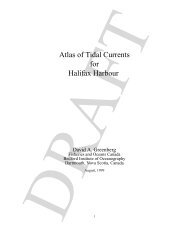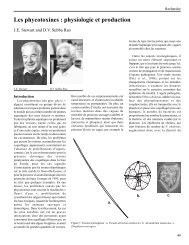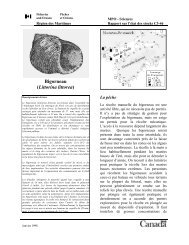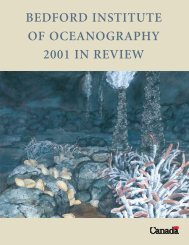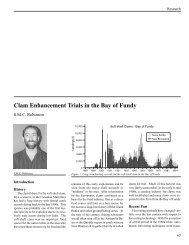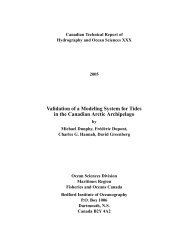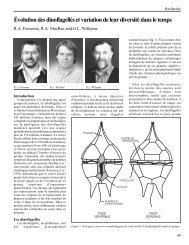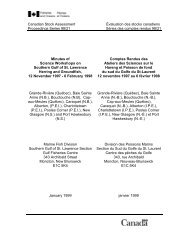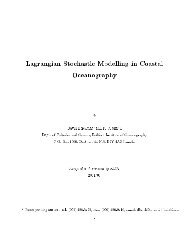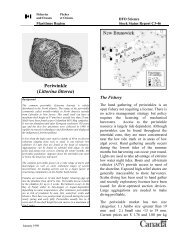Spring Meeting - Région des Maritimes
Spring Meeting - Région des Maritimes
Spring Meeting - Région des Maritimes
Create successful ePaper yourself
Turn your PDF publications into a flip-book with our unique Google optimized e-Paper software.
Fisheries and Oceans<br />
Science<br />
Pêches et Océans<br />
Sciences<br />
C S A S<br />
Canadian Stock Assessment Secretariat<br />
S C É S<br />
Secrétariat canadien pour l’évaluation <strong>des</strong> stocks<br />
Proceedings Series 2000/13 Série <strong>des</strong> compte rendus 2000/13<br />
Proceedings of the<br />
<strong>Maritimes</strong> Regional Advisory Process<br />
of the Georges Bank Scallop Stock<br />
5 April 2000<br />
Bedford Institute of Oceanography<br />
René Lavoie, Chairman<br />
Department of Fisheries and Oceans<br />
Bedford Institute of Oceanography<br />
PO Box 1006<br />
Dartmouth, Nova Scotia<br />
B2Y 4A2<br />
July 2000
<strong>Maritimes</strong> Region<br />
Georges Bank Scallop<br />
Proceedings of the<br />
<strong>Maritimes</strong> Regional Advisory Process<br />
of the Georges Bank Scallop Stock<br />
5 April 2000<br />
Bedford Institute of Oceanography<br />
René Lavoie, Chairman<br />
Department of Fisheries and Oceans<br />
Bedford Institute of Oceanography<br />
PO Box 1006<br />
Dartmouth, Nova Scotia<br />
B2Y 4A2<br />
July 2000
Foreword<br />
These Proceedings are a record of the discussions at the <strong>Maritimes</strong> Regional Advisory Process (RAP) Georges Bank<br />
scallop stock meeting of 5 April 2000. They were prepared by volunteer rapporteurs and reviewed by all<br />
participants at (following) the meeting. Their purpose is to archive the activities and discussions of the meeting,<br />
including research recommendations, uncertainties and to provide a place to formally archive official minority<br />
opinions on status reports. As such, interpretations and opinions presented in this report may be factually incorrect<br />
or misleading, but are included to record as faithfully as possible what transpired at the meeting. No statements are<br />
to be taken as reflecting the consensus of the meeting unless they are clearly identified as such. Therefore, the<br />
Status Reports, which contain the consensus decisions of the meeting, should be used as sources of information of<br />
the status of the resources assessed. Additionally, the short summaries of stock status presented in these proceedings<br />
should not be referenced. The information on which the Status Reports are based are documented in the CSAS<br />
Research Document Series and it is these that should be consulted for an accurate reading of this information.
<strong>Maritimes</strong> Region<br />
Georges Bank Scallop<br />
TABLE OF CONTENTS<br />
Abstract / Résumé.................................................................................................................. 4<br />
Introduction............................................................................................................................ 5<br />
Georges Bank Scallop............................................................................................................ 5<br />
Appendix 1. List of Participants ............................................................................................ 8<br />
Appendix 2. Invitation Letter................................................................................................ 9<br />
Appendix 3. Agenda ..............................................................................................................11<br />
Appendix 4. <strong>Meeting</strong> Remit...................................................................................................12<br />
Appendix 5. List of Documents Tabled.................................................................................12<br />
Appendix 6. List of Research Recommendations..................................................................12<br />
3
<strong>Maritimes</strong> Region<br />
Georges Bank Scallop<br />
ABSTRACT<br />
These proceedings record discussions that were held during the Regional Advisory Process<br />
(RAP) meeting on the Georges Bank scallop stock in <strong>Maritimes</strong> Region in April 2000. The<br />
scientific peer review was conducted at the Bedford Institute of Oceanography (BIO) in<br />
Dartmouth on April 5, 2000. The discussions and related documentation from this meeting are<br />
presented in this document.<br />
RÉSUMÉ<br />
Ces comptes rendus résument les discussions qui ont eu lieu au cours <strong>des</strong> réunions du Processus<br />
de consultation régionale (PCR) relativement aux stock de pétoncles du Banc de Georges dans la<br />
Région <strong>des</strong> <strong>Maritimes</strong> en l'an 2000. L' évaluation détaillée a eu lieu le 5 avril 2000 à l’Institut<br />
océanographique de Bedford (IOB) à Dartmouth.. Ce document présente un compte rendu de<br />
cette réunion et les documents pertinents.<br />
4
<strong>Maritimes</strong> Region<br />
Georges Bank Scallop<br />
INTRODUCTION<br />
The meeting to review the status of Georges Bank scallop was convened on 5 April 2000, in the<br />
sixth Floor Boardroom, Polaris Building, Bedford Institute of Oceanography, Dartmouth, Nova<br />
Scotia. The Chairperson, René Lavoie welcomed the participants (Appendix 1). The letter of<br />
invitation with a list of invitees is in Appendix 2 and the agenda and remit are given in<br />
Appendices 3 and 4, respectively. The list of documents tabled and research recommendations<br />
are given in Appendices 5 and 6.<br />
Working Paper:<br />
Robert, G., G.A.P. Black, M.A.E. Butler, and S.J. Smith. 2000. Georges Bank Scallop Stock<br />
Assessment – 1999. DFO RAP Working Paper 2000/31.<br />
Referee: R.K. Mohn<br />
Rapporteur: S.J. Smith<br />
Remit:<br />
• Assess the status of Georges Bank scallop until 31 December 2000. The assessment should<br />
include:<br />
− An age-structured population analysis, incorporating catch and survey data.<br />
− Where possible, address research recommendations raised from previous RAP meetings<br />
in March/April 1999.<br />
− Provide updated advice for the 2000 fishery and preliminary advice for the 2001 fishery.<br />
− Produce an Offshore Scallop Stock Status Report and supporting Research Document,<br />
documenting the results of the assessment.<br />
Summary<br />
1. In 1998, the management plan for Georges Bank recognized two management areas —<br />
Georges ‘a’, which encompassed the traditional scallop fishing area on the bank, and<br />
Georges ‘b’, which is in the deeper area of the northern edge of the bank where scallop yield<br />
is characteristically low.<br />
2. Scallop fishing in Georges ‘b’ is managed through the use of incremental quotas over a set<br />
period of time referred to as ‘rollover’ TACs. The TAC was allowed to roll over six times in<br />
1999 based upon the monitoring results of the catch rates and meat counts for a total landing<br />
of 1200 t.<br />
3. Scallop fishing in Georges ‘a’ is managed by an annual TAC and the following points refer<br />
to this area only.<br />
5
<strong>Maritimes</strong> Region<br />
Georges Bank Scallop<br />
4. Catch and TAC were 2500 t in 1999. The 1994 and 1995 year-classes contributed to 70% of<br />
the catch by weight.<br />
5. Annual catch rates in 1999 rose 35% from those in 1998 and effort decreased by 32% over<br />
the same period.<br />
6. The total biomass estimate in 1999 is 20% higher that estimated for the previous year. The<br />
directed biomass estimate (ages 4–7) has also increased by over 25% from 1998.<br />
7. The incoming year-class (1996) for the 2000 fishery is among the strongest encountered over<br />
the last 20 years.<br />
8. At an exploitation rate of 13% on the directed age group (ages 4–7) which results in keeping<br />
the effort at the 1999 level, the TAC for 2000 would be 3200 t. At the F 0.1 exploitation rate<br />
of 26%, the resulting TAC of 6050 t would allow the biomass to increase by 6%. The F max<br />
exploitation rate of 40% would result in a TAC of 8600 t and an 11% decrease in biomass.<br />
9. The fishery should experience a few good years as a strong pulse of recruits from the 1996<br />
year-class is currently recruiting to the fishery.<br />
Issues<br />
1. There is very strong evidence for a significant increase in growth rate in 1999, especially for<br />
scallops of the 1996 year-class. This evidence inclu<strong>des</strong> observations made during the survey,<br />
comparisons of shell height and age compositions from survey and commercial catches<br />
between 1999 and previous years and observations from the fishing industry. It was thought<br />
that these changes accounted for the fact that, contrary to past experience, commercial catch<br />
rates continue to increase throughout the year.<br />
2. Adaptive allocation sampling <strong>des</strong>igns have been experimented with during the survey in<br />
1998 and 1999. Results indicate this approach can result in gains in precision of the<br />
abundance estimates. More work is needed on the definition of extra-sampling decision rules<br />
before this approach becomes fully implemented.<br />
3. ADAPT model used here was highly constrained as it was fit to ages 4 to 7 combined only.<br />
As a result, the model could not provide an estimate for the population numbers of age 3 for<br />
the projection to 2000. As a consequence, a geometric mean of age three estimates over the<br />
time series was used and, based upon estimates from the survey, this estimate was probably<br />
an underestimate of the abundance of the 1996 year-class. The increased growth rate noted<br />
above also resulted in a proportion of the 1996 year-class appearing as age 4 scallops in 1999<br />
in the model and hence contributed further to the under-estimation of the strength of this<br />
year-class.<br />
4. A size-based production model (Collie-Sissenwine model) was applied to the data and the<br />
resulting estimates of population numbers, biomass and fishing mortality were very similar to<br />
those from the ADAPT model. While these results may indicate robustness on the part of the<br />
6
<strong>Maritimes</strong> Region<br />
Georges Bank Scallop<br />
ADAPT model to problems in using the same age/shell height relationship over all years, the<br />
Collie-Sissenwine model did have problems with the change in growth rate in 1999. Ad hoc<br />
changes to the definition of the shell-height range for the recruiting year-class appeared to<br />
help but a more rigorous analysis is needed.<br />
Research Recommendations<br />
1. Currently, one shell-height/age relationship is used to estimate age compositions for all years.<br />
Given the observation that growth rates appeared to increase in 1999 compared to other<br />
years, the sensitivity of the ADAPT model to annual changes in growth should be<br />
investigated. This problem has been identified in past RAP meetings but the lack of<br />
resources in the Invertebrate Division has not allowed for progress to be made.<br />
2. The sensitivity of the ADAPT results to the assumption of negligible contribution to both the<br />
survey and the catch of scallops caught in area Georges ‘b’ prior to 1998 needs to be<br />
evaluated. At least, the actual proportions of commercial and survey catch originating from<br />
Georges ‘b’ could be presented for a number of years.<br />
7
<strong>Maritimes</strong> Region<br />
Georges Bank Scallop<br />
Appendix 1. Participants<br />
Georges Bank Scallop RAP<br />
5 April 2000<br />
Participant Address Telephone Fax e-mail<br />
René Lavoie, Chair<br />
Stephen Smith<br />
Amy Chisholm<br />
Roger Stirling<br />
Ginette Robert<br />
Greg Stevens<br />
Gerald Mossman<br />
Bob Mohn<br />
Jerry Black<br />
Maureen Butler<br />
DFO, BIO<br />
Dartmouth,N.S.<br />
DFO, BIO<br />
Dartmouth, N.S.<br />
DFO, BIO<br />
Dartmouth, N.S.<br />
SPANS<br />
Dartmouth, N.S.<br />
DFO, BIO<br />
Dartmouth, N.S.<br />
DFO, Marine House<br />
Dartmouth, N.S.<br />
N.S. Dept. of Fisheries<br />
Halifax, N.S.<br />
DFO, BIO<br />
Dartmouth, N.S.<br />
DFO, BIO<br />
Dartmouth, N.S.<br />
DFO, BIO<br />
Dartmouth, N.S.<br />
(902) 426-2147 (902) 426-8484 lavoier@mar.dfo-mpo.gc.ca<br />
(902) 426-3317 (902) 426-1862 smithsj@mar.dfo-mpo.gc.ca<br />
(902) 5342<br />
(902) 463-7790 (902) 469-8294 spans@fox.nstn.ca<br />
(902) 426-2616 (902) 426-1862 g.robert@ns.sympatico.ca<br />
(902) 426-5433 (902) 426-9683 stevensg@mar.dfo-mpo.gc.ca<br />
(902) 424-4560 (902) 424-1766<br />
(902) 426-4592 (902) 426-1506 mohnr@mar.dfo-mpo.gc.ca<br />
(902) 426-2950 (902) 426-1506 blackj@mar.dfo-mpo.gc.ca<br />
(902) 426-5342 (902) 426-1862 butlerm@mar.dfo-mpo.gc.ca<br />
8
<strong>Maritimes</strong> Region<br />
Georges Bank Scallop<br />
Appendix 2. Invitation Letter<br />
<strong>Maritimes</strong> Region<br />
Science Branch<br />
P.O. Box 1006<br />
Dartmouth, NS, B2Y 4A2<br />
Région <strong>des</strong> <strong>Maritimes</strong><br />
Direction <strong>des</strong> sciences<br />
C.P. 1006<br />
Dartmouth, N.-E., B2Y 4A2<br />
March 9, 2000 le 9 mars 2000<br />
Distribution<br />
Liste de diffusion<br />
Subject: Peer review of Georges Bank<br />
scallop stock Stocks<br />
The assessment of Georges Bank scallop<br />
stocks in <strong>Maritimes</strong> Region will be reviewed<br />
in the 6 th Floor Boardroom, Polaris Building,<br />
Bedford Institute of Oceanography,<br />
Dartmouth, April 5, 2000<br />
The purposes of peer review are: to examine<br />
the scientific approaches of the stock<br />
assessments; to identify any weaknesses in<br />
methodology; to help improve the clarity of<br />
assessments; to make research<br />
recommendations; and to develop<br />
collaborative research programs.<br />
The peer review inclu<strong>des</strong> detailed review of<br />
stock assessments and Stock Status Reports.<br />
A detailed stock assessment of the offshore<br />
scallop stock (Georges Bank ) will be done<br />
Copies of the draft assessment and the draft<br />
stock status report will be sent to the referee<br />
one week before the meeting to allow him<br />
time to become familiar with the material. At<br />
the meeting, science staff will provide a brief<br />
overview of the assessments which should<br />
include: the main conclusions, the supporting<br />
evidence, any new methods, and major<br />
limitations. The presentation will be followed<br />
Objet : Examen par les pairs du stock de<br />
pétoncles du Banc de Georges<br />
Le 5 avril, 2000, on procédera dans la salle du<br />
6ième Étage, Édifice Polaris de l’Institut<br />
océanographique de Bedford à Dartmouth à<br />
l'évaluation du stock de pétoncles du Banc de<br />
Georges<br />
L’examen par les pairs vise à; examiner les<br />
métho<strong>des</strong> scientifiques ayant présidé aux<br />
évaluations <strong>des</strong> stocks; à relever les faiblesses<br />
dans la méthodologie; à contribuer à améliorer<br />
la clarté <strong>des</strong> évaluations; à formuler <strong>des</strong><br />
recommandations pour la recherche; et à mettre<br />
au point <strong>des</strong> programmes de recherche en<br />
collaboration.<br />
L’examen par les pairs comprend un examen<br />
détaillé <strong>des</strong> évaluations <strong>des</strong> stocks et <strong>des</strong><br />
rapports sur l’état <strong>des</strong> stocks. On effectuera une<br />
évaluation détaillée du stock de pétoncles au<br />
large <strong>des</strong> côtes (banc Georges.<br />
Copies de l'évaluation provisoire et de<br />
l’ébauche du rapport sur l’état <strong>des</strong> stocks seront<br />
envoyées à l'examinateur une semaine avant la<br />
réunion pour lui permettre de se familiariser<br />
avec les documents. À la réunion, le personnel<br />
<strong>des</strong> sciences donnera un bref aperçu de ses<br />
évaluations, soit les principales conclusions, les<br />
preuves à l’appui, les nouvelles métho<strong>des</strong> et les<br />
principales contraintes. L’exposé sera suivi<br />
9
<strong>Maritimes</strong> Region<br />
by comments from any of the scientific<br />
referees and then from any of the observers.<br />
The finalised stock status report will be<br />
prepared at the meeting. The minutes of this<br />
meeting will be published as a proceedings.<br />
We greatly appreciate your contribution to<br />
this valuable exercise.<br />
Georges Bank Scallop<br />
d’observations formulées par l'examinateur<br />
scientifique puis par les observateurs. La<br />
version définitive du rapport sur l’état du stock<br />
sera préparées à la réunion et le procès-verbal<br />
de la réunion sera publié comme délibérations.<br />
Nous vous remercions beaucoup de votre apport<br />
à cet important exercice.<br />
Original signed by / Copie originale signée par<br />
René E. Lavoie, Ph. D.<br />
RAP Committee Chairman<br />
Science Branch / Direction <strong>des</strong> Sciences<br />
<strong>Maritimes</strong> Region / Région <strong>des</strong> <strong>Maritimes</strong><br />
Bedford Institute of Oceanography / Institut océanographique de Bedford<br />
P.O. Box 1006 / C. P. 1006<br />
Dartmouth, NS B2Y 4A2<br />
Tel : (902) 426-2147; FAX (902) 426-8484<br />
e-mail / courriel : lavoier@mar.dfo-mpo.gc.ca<br />
c.c. :<br />
M. Sinclair<br />
R. O’Boyle<br />
S. Smith<br />
Distribution / Diffusion :<br />
Scientific referees /<br />
Examinateurs scientifiques<br />
Government observers /<br />
Observateurs du gouvernement<br />
Industry observers /<br />
Observateurs de l’industrie<br />
R. K. Mohn, BIO/IOB Greg Peacock, <strong>Maritimes</strong> Angela Bugden<br />
Bruce Osborne, NS/N.-É.<br />
Jim Mosher<br />
Greg Stevens, <strong>Maritimes</strong><br />
Eric Roe<br />
Tim Surette, DFO/MPO, Yarmouth Roger Stirling<br />
10
<strong>Maritimes</strong> Region<br />
Georges Bank Scallop<br />
Appendix 3. Agenda<br />
Peer review of Georges Bank scallop stock /<br />
Examen par les pairs du stock de pétoncles du Banc de Georges<br />
Proposed timetable / Calendrier proposé<br />
April 5 / le 5 avril Time / Heure Lead / Responsable<br />
Introduction 1000-1010 /<br />
R. E. Lavoie<br />
de 10 h à 10 h 10<br />
Scallop: Georges Bank /<br />
Pétoncles : Banc Georges<br />
1010-1230 /<br />
de 10 h 10 à 12 h 30<br />
Critique & discussion 1330-1500 /<br />
de 13 h 30 à 15 h<br />
SSR Georges Bank Scallop /<br />
RES Pétoncles du Banc Georges<br />
1500-1700 /<br />
de 15 h à 17 h<br />
G. Robert<br />
R. K. Mohn &<br />
Observers/observateurs<br />
all<br />
11
<strong>Maritimes</strong> Region<br />
Georges Bank Scallop<br />
Appendix 4. <strong>Meeting</strong> remit.<br />
• Assess the status of Georges Bank scallop until 31 December 2000. The assessment should<br />
include:<br />
− An Age-structured population analysis incorporating catch and survey data.<br />
− Where possible, address research recommendations raised from previous RAP meetings<br />
in March/April 1999.<br />
− Provide updated advice for the 2000 fishery and preliminary advice for the 2001 fishery.<br />
− Produce an Offshore Scallop Stock Status Report and supporting Research Document<br />
documenting the results of the assessment.<br />
Appendix 5. List of Documents Table.<br />
Robert, G., G.A.P. Black, M.A.E. Butler, and S.J. Smith. 2000. Goreges Bank Scallop Stock<br />
Assessment – 1999. DFO RAP Working Paper 2000/31.<br />
Appendix 6. List of Research Recommendations<br />
1. Currently, one shell-height/age relationship is used to estimate age compositions for all years.<br />
Given the observation that growth rates appeared to increase in 1999 compared to other<br />
years, the sensitivity of the ADAPT model to annual changes in growth should be<br />
investigated. This problem has been identified in past RAP meetings but the lack of<br />
resources in the Invertebrate Division has not allowed for progress to be made.<br />
2. The sensitivity of the ADAPT results to the assumption of negligible contribution to both the<br />
survey and the catch of scallops caught in area Georges ‘b’ prior to 1998 needs to be<br />
evaluated. At least, the actual proportions of commercial and survey catch originating from<br />
Georges ‘b’ could be presented for a number of years.<br />
12



